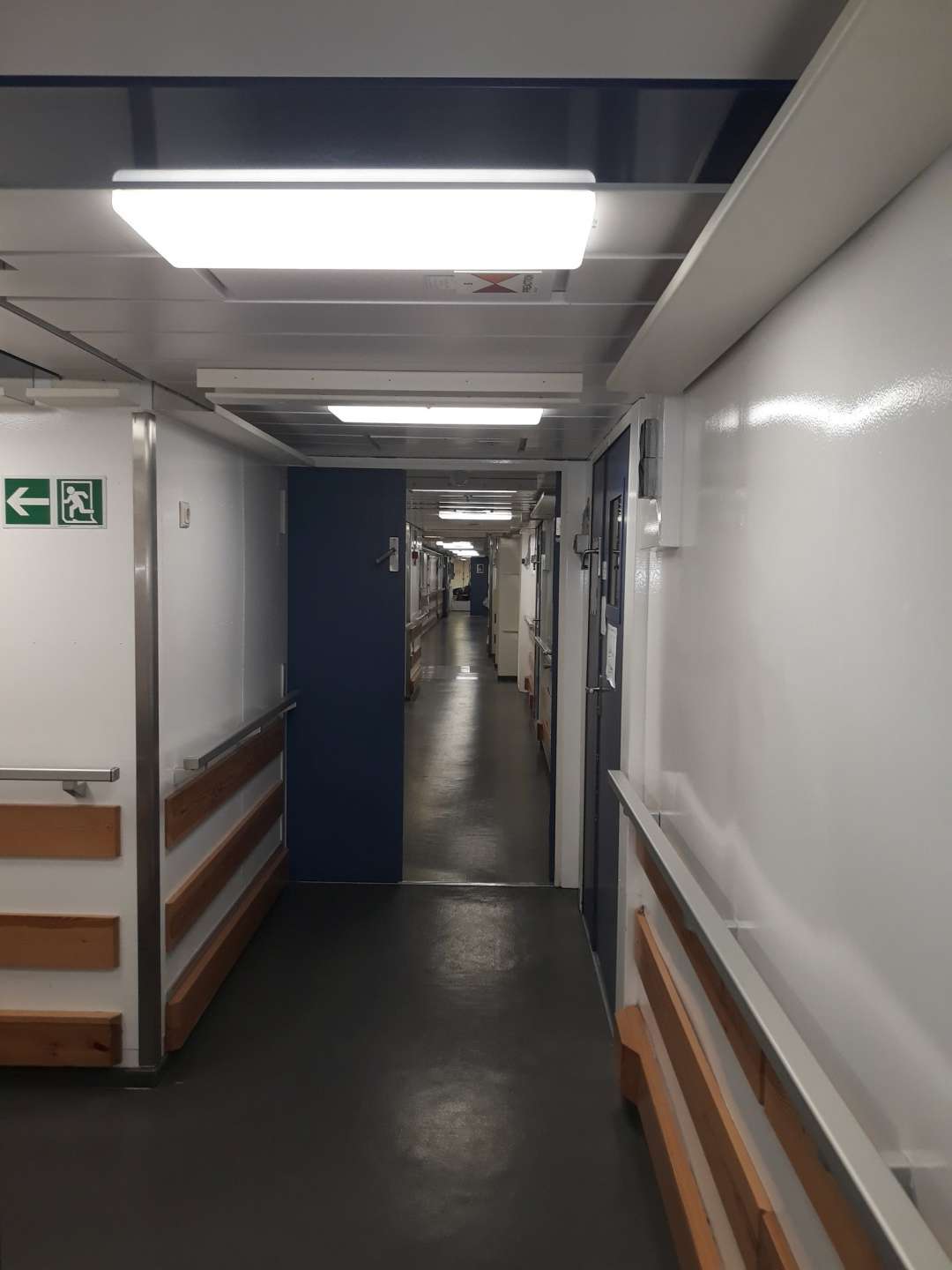And another night shift
My cell phone is buzzing. It’s 1:00 a.m., in the middle of the night. I open my eyes. Not a bit of light comes through the bull’s-eyes. Out of bed, shower, get dressed. I didn’t sleep long, a few hours or so. Good morning.
The weather seems to be good. The ship rolls only very slightly and does not pitch. Consequently, there may be a beautiful sunrise ater. Let’s wait and see.
My first walk is always up to the hangar and the work deck. The corridors are empty. In the back of the wet lab, people are sorting, photographing, labeling and documenting. Work is done 24/7, there is always someone somewhere.
In the hangar (hangar because the room is two decks high and quite large. Nevertheless, airplanes don’t fit in here) sits Thomas. He is on watch. My first look is at the winch display. If the number gets bigger then the instrument goes down, if it gets smaller then the instrument comes back. 3832 m and increasing. Thomas confirms: the MUC is on its way down. We are on schedule, about 04:00 a.m., my instrument goes in the water. I’m going to get a coffee.
Together with my friend the coffee, I go to my lab. I have to prepare everything necessary for the EBS mission. Boot up the computer, check battery charges, program probes and do the necessary calculations for the deployment. Tonight it is epibenthic sled deployment No. 22.
Here on board the RV Sonne, I am the deployment manager, responsible for the deployment and technology of the epibenthic sledge, or EBS for short. The name comes from Epi from the Greek for “on” or “on top”, and Benthos is the community of the seabed and sled, because the device is pulled over the bottom. With the EBS, we catch animals that live directly on the seabed. The sled weighs about 500 kg, is 5 m long with its cable harness. It has two fine horizontal nets with a mesh size of one-half mm. It is built in such a way that the nets are closed in the water column and open only at the seabed. This ensures that only animals from the very bottom are collected. Everyone simply calls the EBS “the tin can”.
Today, the deployment area is 7200 m deep. My calculations result in a cable length of 9300 m, the ship has an approach distance of 3.25 nautical miles (nm), the deployment takes about 8.5 hours.
I’ve already looked at Anne and Kevin’s bathymetry beforehand, to see what the seafloor is like in this region, and whether there are trenches, ridges or even small seamounts that I should not cross with the sled. There is always the risk that the EBS will get stuck somewhere between rocks and get lost. But here there are no problems. The seabed is smooth and unproblematic for three nautical miles in any direction.
It’s just after 03:00 a.m. and I go up on the stoop with my numbers. I discuss where I want to go with the officer in charge.
On the one hand, we want to set the EBS down in an area previously agreed upon with all scientists, on the other hand we must consider which towing direction is permitted by the wind, waves and current. We have only little wind, 3-4 m/s and waves of under 1.5 m. That makes it easy. So today to the northeast, against the wind, the waves from diagonally forward in the direction of 290°.
Now it’s time to prepare the sled. My colleague Andreas (he has already written about the EBS) is now also in the lab. We put on our work clothes and shoes. We mount the sensors on the sled, the net cups at the end of the nets for catching the animals and check if everything is still OK.
At 04:30 a.m., a little later than planned, the EBS goes into the water and I return to the bridge. From there, I monitor the sled on its way down into the deep sea. Using various parameters such as ship speed, cable length, position, and winch pull, I get accurate information on where the sled is at any given time. I can track exactly when the unit hits the seafloor, how long we pull the sled over the bottom, and when the EBS leaves the seafloor again. All of this takes time, most of which I spend sipping coffee in front of the various monitors and recorders. Andreas keeps me company.
Slowly it gets brighter. At some point we can see the horizon, the morning is dawning. The sea around us is calm. The sunrise is unfortunately cancelled, far too many clouds today.
In the late morning the EBS is back on deck. We then take the samples from the nets, bring the sensors back to the lab and save data such as pressure, temperature, salinity and oxygen. Back in the wet lab, the animals are sorted, photographed, labeled and documented.
I then continue to write the field protocols and type initial results into the databases. It is noon by the time I am done with everything.
In about 12 hours, it will be my turn for the next EBS deployment. That will be another night shift.
Nils Brenke
written on board RV Sonne 53° 23,399′ N 162° 10,733′ W North Pacific,
for my dear family, my nice neighbors, my good friends and of course for all the other friendly readers.





